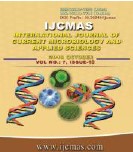


 National Academy of Agricultural Sciences (NAAS)
National Academy of Agricultural Sciences (NAAS)

|
PRINT ISSN : 2319-7692
Online ISSN : 2319-7706 Issues : 12 per year Publisher : Excellent Publishers Email : editorijcmas@gmail.com / submit@ijcmas.com Editor-in-chief: Dr.M.Prakash Index Copernicus ICV 2018: 95.39 NAAS RATING 2020: 5.38 |
Field and laboratory experiments were carried out to evaluate the effect of different decontamination processes on reduction of profenofos and chlorpyrifos residues in cauliflower curds like washing, cooking, washing plus cooking and dipping in chemical solutions after application of Profex 50EC (profenofos 50%) and Lethal 20EC (chlorpyrifos 20%) individually on the crop. Profex 50EC was applied twice at the rate of 0.8ml/L and Lethal 20EC @ 2.50ml/L at 15 days interval on cauliflower crop. Cauliflower curds were collected at 0 (2 hours) and 3 days interval for profenofos and for chlorpyrifos curds were sampled at 0 (2 hours), 3 and 7 days after the last spray and subjected to decontamination processes. Washing of zero day contaminated curd samples provided 26.06-67.09% relief from profenofos residues and 35.44-67.18% relief from chlorpyrifos residues. Cooking degraded profenofos residues up to 37.17-67.57% and chlorpyrifos residues by 36.00-56.80%. Washing plus cooking removed profenofos and chlorpyrifos residues up to 70% as compared to other processes and proved to be the best technique in removing the residues. Washing of curds with 2% NaOH solution reduced the profenofos residues up to 67.09-70.30%, whereas washing with 0.05% solution of HCl reduced the profenofos residues up to 63.48-65.52%. Similarly chlorpyrifos residues were reduced to 40.00-67.18% after treatment with 2% NaOH solution and up to 44.00-61.17% after treatment with 0.05% HCl solution.
 |
 |
 |
 |
 |